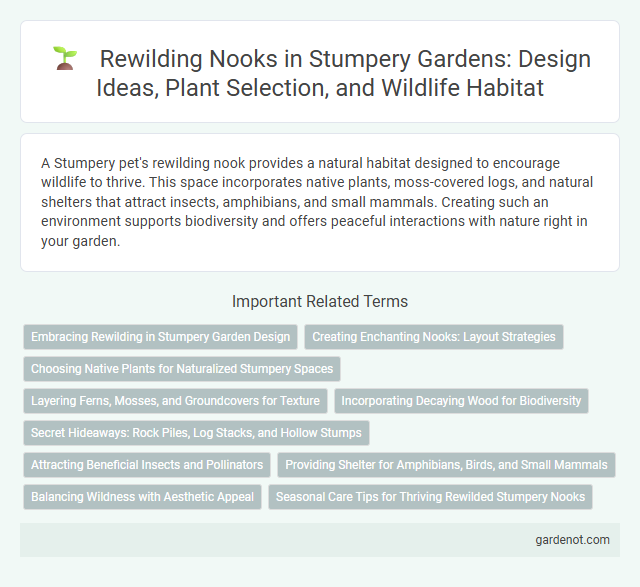A Stumpery pet's rewilding nook provides a natural habitat designed to encourage wildlife to thrive. This space incorporates native plants, moss-covered logs, and natural shelters that attract insects, amphibians, and small mammals. Creating such an environment supports biodiversity and offers peaceful interactions with nature right in your garden.
Embracing Rewilding in Stumpery Garden Design
Rewilding in stumpery garden design transforms deadwood into a thriving habitat, fostering biodiversity by encouraging native flora and fauna. Creating a rewilding nook promotes natural processes such as decomposition, essential for soil health and supporting pollinators like bees and butterflies. Integrating mosses, ferns, and wildflowers around stumps enhances ecosystem resilience and provides shelter for insects and small wildlife.
Creating Enchanting Nooks: Layout Strategies
Designing a rewilding nook within a stumpery involves strategic layering of native ferns, mosses, and decaying wood to cultivate a naturalistic habitat that attracts diverse wildlife. Positioning stumps and logs in varied orientations creates microhabitats for insects and small mammals, enhancing biodiversity and visual interest. Incorporating shade-tolerant plants around these features emphasizes a woodland ambiance, fostering an enchanting and immersive green space.
Choosing Native Plants for Naturalized Stumpery Spaces
Selecting native plants such as ferns, mosses, and wildflowers enhances biodiversity in a rewilding nook within a naturalized stumpery, promoting ecological balance. Native species adapt well to local soil and climate conditions, reducing the need for maintenance and supporting native wildlife like pollinators and birds. Integrating a mix of shade-tolerant plants ensures year-round interest and a thriving, sustainable habitat in the naturalized space.
Layering Ferns, Mosses, and Groundcovers for Texture
Layering ferns, mosses, and groundcovers in a rewilding nook enhances biodiversity by creating varied microhabitats essential for wildlife. This textural layering mimics natural forest floors, promoting soil health and moisture retention while offering shelter and foraging spaces for insects and small animals. Incorporating native species such as Dryopteris ferns, Hypnum mosses, and Pachysandra groundcovers maximizes ecological benefits and resilience in stumpery ecosystems.
Incorporating Decaying Wood for Biodiversity
Incorporating decaying wood within a rewilding nook enhances biodiversity by providing essential habitats for fungi, insects, and small mammals, promoting ecological balance. This natural decomposition process enriches soil nutrients and supports native plant regeneration, fostering a resilient ecosystem. Creating stumperies with varied wood decay stages maximizes microhabitat diversity, essential for sustaining diverse species populations.
Secret Hideaways: Rock Piles, Log Stacks, and Hollow Stumps
Secret hideaways within a stumpery, such as rock piles, log stacks, and hollow stumps, create vital microhabitats that foster biodiversity by providing shelter and breeding grounds for insects, amphibians, and small mammals. These natural structures mimic forest floor complexity, enhancing soil health and promoting native plant regeneration crucial for successful rewilding projects. Incorporating such elements into a rewilding nook supports ecosystem resilience while offering immersive, nature-rich experiences for visitors.
Attracting Beneficial Insects and Pollinators
A rewilding nook within a stumpery attracts beneficial insects and pollinators by providing diverse native plants and decaying wood habitats essential for their life cycles. Fallen logs and mossy crevices create sheltered microhabitats, supporting species like solitary bees, ladybugs, and lacewings that enhance garden biodiversity and pest control. Incorporating flowering plants rich in nectar and pollen sustains pollinator populations, promoting a healthier ecosystem.
Providing Shelter for Amphibians, Birds, and Small Mammals
A stumpery designed as a rewilding nook offers essential shelter and breeding grounds for amphibians, birds, and small mammals by mimicking natural woodland debris. The layered arrangement of decaying wood and crevices creates microhabitats that regulate moisture and temperature, crucial for species such as frogs, hedgehogs, and wrens to thrive. This habitat enhancement supports biodiversity by providing refuge, foraging opportunities, and protection from predators within garden ecosystems.
Balancing Wildness with Aesthetic Appeal
A rewilding nook in a stumpery integrates native plants and decaying wood, creating habitats that promote biodiversity while maintaining visual harmony. Selecting diverse textures and natural forms ensures ecological value blends seamlessly with garden artistry. Strategic placement of ferns, mosses, and wildflowers enhances both wildlife support and aesthetic appeal.
Seasonal Care Tips for Thriving Rewilded Stumpery Nooks
Rewilding stumpery nooks benefit from seasonal care that enhances habitat diversity and plant resilience. In spring, clearing invasive species and adding native wildflowers promotes pollinator activity, while autumn calls for leaf mulching and moisture retention to prepare for winter dormancy. Regular monitoring for pest activity and avoiding chemical treatments support the thriving biodiversity essential to rewilded ecosystems.
Rewilding nook Infographic

 gardenot.com
gardenot.com